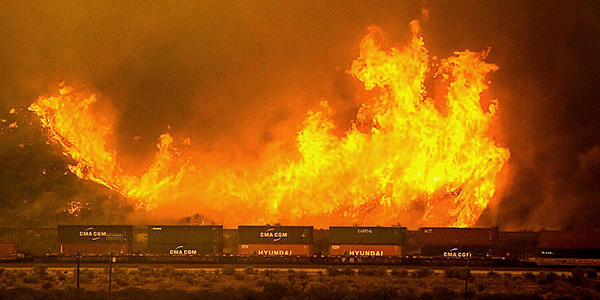By Rich Heidorn Jr.
WASHINGTON — NERC CEO Jim Robb said Thursday he is pushing for new reliability standards to address fuel assurance concerns and ride-through settings for inverters on solar generation and storage.
“I think a standard will be called for” on inverters, Robb said during a press conference at NERC’s D.C. office marking six months since he took the organization’s helm. “I feel the same way about fuel assurance. But my eyes are wide open to the challenges in crafting those appropriate [requirements] and figuring out which entities should be accountable for them.” (See related story, New NERC Chief Not ‘Smartest Guy in the Room.’)
NERC has issued two alerts on inverters, one after the 2016 Blue Cut wildfire near Los Angeles caused transmission line faults and disconnected 1,200 MW of solar resources, and a second following a fire in spring 2018. Both were Level II alerts, which required registered entities to respond to NERC’s recommendations and answer questions about solar generation in their footprints and how they plan for the loss of the resources.
NERC is now finalizing a reliability guideline to ensure inverters are configured “so they play nicely with the rest of the system,” Robb said. “An inverter can do almost anything you want it to do. You just have to tell it what to do.”
Robb said the issue is a concern not only in California and the Southwest but also in North Carolina, Massachusetts and Texas, where solar penetration is rising. Battery storage also uses inverters and presents similar issues, he said.
“The issue around the standard that we’re currently struggling with is that right now all of our standards … are technology-agnostic and fuel-agnostic,” Robb said. “So, this would be the first that we would put in for a specific technology. And not everyone’s embracing that notion, so we have some work to do.” (See Solar Inverter Problem Leads CAISO to Boost Reserves.)
Fuel Assurance Standard
The shift from baseload coal and nuclear generation to variable resources and natural gas also justifies a reliability standard, Robb said.
“Loads are becoming much less certain than what we’ve had in the past. In fact, to be perfectly honest, we don’t know what the load curve of California looks like anymore because so much of it is masked by the distributed solar panels on peoples’ roofs,” he said. “We have a lot of tools and a lot of rules … we use to operate and manage and plan the system that are all largely based on a 1950s view of the world [that’s not] really true anymore.”
One of the challenges is aligning the natural gas industry’s infrastructure, scheduling policies and modeling to the real-time needs of the electric industry.
“Those [gas] power plant ramp rates are getting steeper and steeper” in the afternoons, when solar generation drops as loads peak, Robb said. “And effectively what we’re seeing is power plants were sucking gas out of the distribution system faster than pipelines could pack it in.”
Although pipelines can provide some storage by increasing pressure in their systems, “what we’re seeing in areas like the Southwest … is some of the pipeline corridors are running 90 to 95% of capacity. So they don’t have the same degree of flexibility they would have had five, 10 years ago.”
In addition, because of the way gas is regulated, “there is really no [one] who can solve these problems with the stroke of a pen,” Robb said.
Natural gas problems are most acute in New England and Florida, which have limited pipeline infrastructure, and California, which has lost most of Aliso Canyon’s storage capacity. (See related story, CAISO Seeks to Extend Aliso Canyon Rules.)
Although NERC’s current standards address planning for contingencies, they are “relatively vague as to how to think about fuel as a contingency,” Robb said.
“So we’re talking through getting a guideline in place that would make clear that any particular entity ought to look at a major pipeline disruption for example [or] a problem on the rail system … and start to factor that into their operating and shorter-term planning.”
Still to be determined is which entities would be subject to a pipeline contingency rule. “The challenge in evaluating the gas system is you need to really look at it over a fairly wide area, probably a bigger footprint than a planning coordinator, certainly a bigger footprint than in individual utility. It might be something that might be best applicable to [a reliability coordinator] but the RCs aren’t really set up to do that kind of planning,” Robb said.
He acknowledged that the industry generally prefers guidelines over standards because the latter can result in enforcement actions. “I choose to think of them as providing great clarity around how things should be done, particularly around these very disparate resources around the system that can interact in ways that don’t contribute to the community event that we call reliability. But it will take us a while to get there.”
Robb also acknowledged that the issue has become politicized by the Trump administration’s efforts to provide price supports for money-losing coal and nuclear generators. “My goal is to make sure that our work remains technically unimpeachable so it’s there to inform people who are making important decisions around these issues but not get drawn into the political and ideological arguments around them.”





